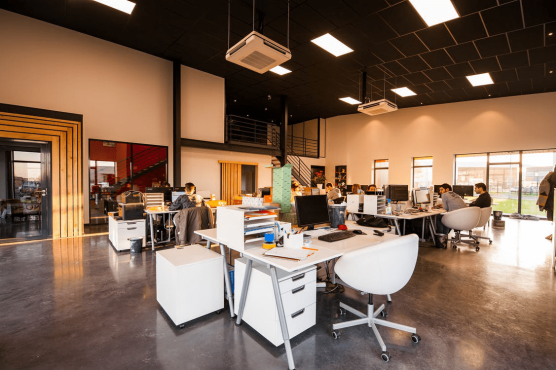Quick Navigation
The Crime Prevention Through Environmental Design (CPTED) approach to ensuring building security is self-explanatory. It is a set of design principles used to reduce the incidence and fear of crime by manipulating the built environment in a way that creates a safer space.
Whether it is residential units, corporate structures, community settings, or commercial places like shopping malls, well-planned buildings almost always rely on the CPTED theory to provide a safe environment for its residents, employees, or customers.
For business owners looking for ways to promote business security, CPTED lies at the very heart of the matter. It helps you secure the premises and prevents theft and other similar fraudulent activities that can otherwise cause significant damages to your business.
According to a study conducted by the Injury Prevention Research Center at the University of California, multistoried buildings experience a 30% to 84% drop in robberies when upgraded according to the principles of CPTED.
Therefore, it’s essential to learn more about the CPTED technique so you can apply it effectively for securing your business.
In this guide, we will cover:
- What is CPTED?
- Why is CPTED important?
- What are the different CPTED principles?
- What is the Three-D approach as it relates to CPTED?

What Does CPTED Mean and Why Is It Important?
As mentioned earlier, CPTED is short for Crime Prevention Through Environment Design. It is an architectural concept because when buildings can withstand harsh weather and natural disasters, they can also be structured to prevent crime.
It first originated in America in the early ‘60s when a criminologist, C. Ray Jeffery, introduced the concept of ‘defensible spaces.’ He explained how neglected zones, poor building maintenance, and certain design aspects could make a particular place more susceptible to robbery and other crimes.
For business security or addressing the crime concerns in any other place, CPTED is a unique, yet highly effective, technique to follow.
Rather than introducing visually unappealing safety measures such as surveillance cameras, security guards, and hard barriers (locks, fences, security gates,.), CPTED focuses on creating a visually pleasing space that encourages positive human behavior.
CPTED is meant primarily for the design of new buildings being constructed from scratch. However, it can also make existing buildings more secure by upgrading them according to a particular set of rules.
CPTED plays a major role in safety and security because it is a proactive step for fighting theft regardless of the scale at which they carry it out. When applying CPTED principles, you expect the thought process of a potential offender. This enables you to build an environment that resists follow-through. CPTED also boosts the sense of security amongst your employees and can also be an effective countermeasure for employee theft.
Want to keep your business safe and secure from thefts? Here is our guide on the best security camera for business reviews as we help a lot of entrepreneurs know of what is the importance of a CCTV in their business.
How Many Core Techniques Does Crime Prevention Through Environmental Design (CPTED) Have?
CPTED comprises four basic principles. These are:
- Natural surveillance
- Natural access control
- Territorial reinforcement
- Maintenance and management
So, what is the underlying philosophy of these four principles, and how do they reduce the likelihood of crime in any place?
The next section will help you find out.
The following are brief descriptions of what each of these CPTED principles entails.
1. Natural Surveillance
Natural surveillance techniques focus on making the place unfavorable for illegal activities. They make it difficult for the potential offender to hide during the process and make an escape thereafter. If a person feels as if they are being watched from different angles at all times, they are less likely to commit a wrong.
Natural surveillance techniques minimize, if not eliminate, the hiding places for the criminal. You can increase natural surveillance on your premises by taking the following measures:
- Ensure all areas are well lit
- Keep entry and exit ways free of objects that block the direct line of sight
- Keep hedges and trees well-trimmed
- Avoid plantation near windows and corners as they create a blind spot
Video surveillance must complement natural surveillance. So, besides these steps, don’t forget that installing a high-quality business security system is a must.
2. Natural Access Control
This technique is meant to demotivate an offender from carrying out their nefarious plans. It stops them from thinking they are in control despite being outsiders in your facility.
You can deny them this sense of control by directing the flow of both vehicles and visitors in a way that makes it more manageable and more visible. Use locks, fences, shrubs, and other similar elements to keep people out of a place unless they have a valid reason for being there.
3. Territorial Reinforcement
Territorial reinforcement is about establishing a clear demarcation between your business premises and the surrounding areas.
A clear distinction between public and private property serves two main purposes. First, it gives your employees a sense of belonging. When they take ownership of the place, they will be more vigilant of people who don’t belong there. Second, territorial reinforcement makes it difficult for intruders to blend in easily without being noticed.
To reinforce your ownership of the place, you can display signage on all entrances, along with installing a badging system for guests and temporary visitors.
4. Maintenance and Management
A poorly managed business property is a welcome place for criminal activities. The more neglected an area is, the more likely it is to become a target for theft and robberies.
It also illustrates this idea in the Broken Window Theory, which states that a broken window will entice a criminal to break another–i.e., any visible signs of vandalism or mismanagement in a building make the place more inviting for more serious crimes.
Therefore, don’t put off repairs and carry out periodic maintenance checks. If something gets damaged, fix it immediately to show that you are always mindful of your property.
CPTED and the Three-D Approach
They implement the four principles of Crime Prevention Through Environmental Design through the ‘three-D approach.’
The three-D approach to CPTED is analogous to the concept of three-dimensional spaces in the real world–i.e., all buildings must be analyzed according to their designation, definition, and design.
When testing your business premises from a security point of view, you need to ask yourself the following questions:
1. Designation
- What is the main purpose of the place?
- Was it originally built for the same purpose?
- If not, how can you change it to maximize functionality and security?
2. Definition
- Is the place well defined, or does it merge with its surroundings instead?
- If the boundaries set it apart from the public property, is it clear who the place belongs to?
- Are the administrative aspects covered in the legal policy?
3. Design
- Does the design and layout of the place match its intended use?
- Does the physical layout temper with the security measures you have put in place?
- If the answer to the above two questions is no, which of the four principles of CPTED, do you need to work upon the most?
End Note
The broad nature and versatility of the CPTED principles make it suitable for securing a wide range of places, including large corporate buildings and standalone units. It can be adapted to match your business’s needs and preferences and can be implemented easily without interfering with the overall functionality of the place.
Plus, it can also help you develop strategic partnerships with local government and community members.
If you want to secure your business from external threats and make it safer for both employees and customers, take the steps for crime prevention through environmental design.



